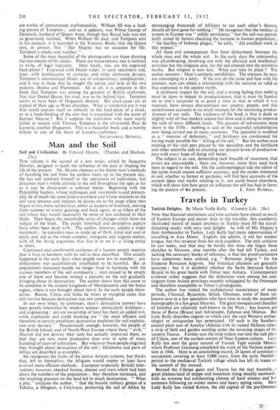Travels in Turkey
Turkish Delights. By Marie Noele Kelly. (Country Life. 18s.)
Now that financial restrictions and iron curtains have closed so much of Eastern Europe and nearer Asia to the traveller, this excellently illustrated record of recent journeys in Turkey must fill the travel- dreaming reader with envy and delight. As wife of His Majesty's then Ambassador to Turkey, Lady Kelly had many opportunities of travelling in Asia Minor. English, she admits, is not her mother tongue, but this reviewer finds her style excellent. The only criticism he can make, and that may be hardly fair since she began these sketches in Moscow, nine months after she had left Turkey, and lacking the necessary books of reference, is that her proof-correctors have sometimes been unkind, e.g. " Romans Argyre '' for the Emperor Romanos Argyros. Her historical allusions are generally accurate ; but it is doubtful whether the Serbs betrayed Sultan Byazid in his- great battle with Timur near Ankara. Contemporary evidence rather suggests that the defections were among the con- tingents from Asiatic provinces recently subjugated by the Ottomans and therefore susceptible to Timur's propaganda.
The author has visited the architectural masterpieces of many periods, Classical, Byzantine, Seljuk, Ottoman, some of them un- known save to a few specialists who have time to study the accessible monographs in a few great libraries. The great mosques and churches of Istanbul are relatively well-known to the West ; less known are those of Bursa (Brusa) and Adrianople, Ephesus and Miletus. But Lady Kelly describes regions to which only the rare Western archae- ologist or antiquarian has penetrated. Of such is the Southern coastal plain east of Antalya (Adalia) with its ruined Hellenic cities, a strip of field and garden nestling under the towering slopes of the western Taurus. Further east the strip widens out into the rich plain of Cilicia, one of the earliest centres of Near Eastern culture. Lady Kelly has seen the great mound of Yumuk Tepe outside Mersin, where Professor Garstang completed the work of the Neilson expedi- tion in 1946. Here is an astonishing record, 26 layers of continuous occupation covering at least 5,000 years, from the early Neolithic period to the mediaeval Turkish village which has left its traces on
the summit of the mound. .
Beyond the Cilician gates and Taurus lies the real Anatolia, s great plateau-land of steppe and mountain rising steadily eastwards, with an extreme but exhilarating climate of hard winters and hot summers following on winter snows and heavy spring rains. Here Lady Kelly has visited Konya, the old capital of the pre-Ottoman Seljuks, with its Dervish tradition, and the stranger and less-known cave-chapels within the natural cones and pyramids that fill the Urgup valley. Her photograph of the fresco of the Adoration of the Magi at Tokale Kilisse and the figures from Goreme are alike admirable, but so indeed are all her illustrations, including those supplied by the Turkish Press department. Outstandingly impressive is the inner door of the little known Seljuk " twin-minaret " at Erzurum. Altogether a very delightful book.
PHILIP P. GRAVES.



























 Previous page
Previous page